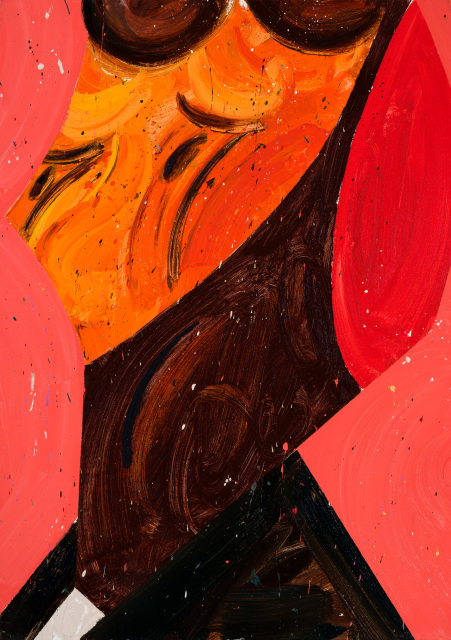Amir Khojasteh and Sabrina Mendoza Malavé’s works intertwine on various levels. On the one hand, their respective countries – Iran and Venezuela – are incurring turbulent political situations. On the other hand, both artists touch those situations and include references to abstraction, pop culture, and poetry.
As is inherent to Khojasteh’s practice, references play a crucial part. Rather than directly relaying what is depicted in those references, the artist extracts what feels relevant. Similarly, Mendoza’s approach includes a candid commentary on the current landscape in Venezuela by using fragments and phrases that allude to the country’s political polarization and the natural infrastructural decay that occurred over time.
The resemblance of Khojasteh’s paintings to the reference images may be just a trace. Influenced by a wide array of images, such as portraits of iconic fighters, Art History, and, more recently, imagery from Iran and the religious icons from its pop culture, Khojasteh shapes an abstract narrative based on immediate feelings - far from imitation. Each portrait loses its real identity and is born into a new situation.
Khojasteh conveys a particular yet abstract situation in this new series of works: being stuck. An image of purgatory comes to mind when experiencing the artist’s impasto-heavy works as they mirror the current situation conspiring in Iran. The work balances a whirlwind of contradictory emotions and situations tied together by that common thread.
Using her practice as a tool to spread awareness about the socio-political turmoil occurring in Venezuela, Mendoza offers a critical perspective on international and national power structures and their impact on people. Referencing current and past events, she relays information that the media doesn’t necessarily portray, where the data is usually one-sided and misinterpreted.
Mendoza’s mixed media sculptural works directly reference artisanal clay houses that depict idealized home façades commonly sold as souvenirs in Latin America and are collected in heaps as decorative pieces. Their display in the space also indicates how these souvenirs are presented in homes: hung together, forming a small-town installation. The way the artist approaches these objects, however, is a complete contrast. Rather than clay, she uses recycled and found materials, and rather than idealized façades, she represents existing infrastructures in different barrios, showing graffiti, protests, decay, and signs of pollution.
The sculptures also make a poignant and acute commentary on how constant exposure to political slogans, protest signs, and media coverage have affected public opinion. By directly referencing these writings in a methodically more poetic way, she breaks down some slogans and inverts them to convey positive and critical messages about unity and understanding in hopes of encouraging contemplation and reconciliation between citizens.
The works of both these artists create a particular provocation by bringing to light and honestly representing the effects of the current political climates on the citizens of Iran and Venezuela. The artists provide a deeper insight into human nature by weighing the scales between rest and unrest, peace and chaos.

